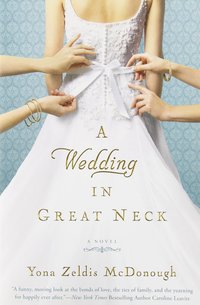You know the old line about not judging a book by its cover? Well, as
reader
and writer I can tell you that it’s a big fat lie. We all judge books by
their
covers, especially when confronting a veritable tidal wave of them on the
shelves and tables of our local Barnes & Noble or indie bookstores. Book
covers
instantly convey information about the kind of book and author we’re
considering. They whisper, they tease, they cajole, seduce and shout. They
are
of vital importance and so we ought to just own up to that fact: what’s on
the
cover is crucial to getting a potential reader to actually pick up your book
and
look inside. And as the author of six novels, twenty-six books for children
and
the editor of two essay collections, I know what I’m talking about.

When my first novel, THE FOUR TEMPERAMENTS, came out from Doubleday in 2002,
I
was pleased with the cover, which was dramatic, bold and intriguing. The
dark
background suggested the novel’s darker aspects and the centrally placed
violin
suggested the curves of a woman’s supine body. The cover was designed to
appeal
to women but not exclusively so; a man might read the book with censure or
embarrassment. This, although I did not fully understand it yet, was a huge
plus.
My second book with Doubleday, IN DAHLIA’S
WAKE, came out three years later. The cover photo—a delicately washed
out
image of a townhouse in brownstone Brooklyn—was evocative and gender
neutral—good things—but also a bit tepid and unmemorable. The book did
significantly less well and I wondered whether the cover might have played a
role.
When I published, BREAKING THE BANK, novel #3, I had switched publishers
and
was now at Downtown Press, a division of Simon & Schuster. Unlike the first
two
books, which came out in hardcover, this one was a paperback original. The
cover, which showed a woman from behind over whose red umbrella a shower of
bills rained down, was good—specific to the book, and attention getting in
its
own right. But the lone female in the red coat was beginning to inch toward
women’s fiction, a neighborhood I would soon inhabit more assertively with
the
publication of novels #4, A WEDDING IN GREAT NECK and #5, TWO OF A
KIND.

The cover of A WEDDING IN GREAT NECK depicts not just a woman but a
bride
from behind and the array of hands that fuss with her dress, as well as the
Tiffany-box blue background and embossed gold lettering fairly pulsate with
the
damning words chick lit, chick lit. And the wedding-themed cover of
TWO OF A
KIND says the same. I happen to love both of these covers and feel they
convey essential thematic information about the books. In the case of A WEDDING
IN
GREAT NECK, which is told from several points of view—though not the
bride’s—I loved how the bride on the cover was being done to. She was an
object,
rather than a subject, and the cover subtly suggested that.
In TWO OF A
KIND, the man and woman are seated apart, separated by an aisle. He is
looking straight ahead; she is looking at him. From their body language we
sense the tension between them, postures that mirror what transpires in the
novel.
The cover of novel # 6, YOU WERE MEANT FOR ME, was even further along the chick-
lit
spectrum. The dominant color scheme is pink and white. And it depicts pink,
peep-toed pumps covered in white polka dots. These pumps face a pair of
shoes
made for a baby girl. I loved this cover. It is bold and arresting in its
own
right, and it really does speak to the book’s essential theme: motherhood as
almost a confrontation with a tiny new stranger. But it is also a very
gender
specific cover; no guy is going to be caught reading that book on the subway
—not
even my husband!
The chick lit association of these covers also tend to lighten and even
cheapen
the words inside them. Now let me say something about chick lit here.
Despite
the fact that women are—and have historically always been—the big consumers
of
novels, the books designed to appeal to our interests and sensibilities are
somehow demoted and tainted with that chick lit brush. It’s a bad brush
too: it
says your book is unimportant, shallow, trivial and not well written.
I’m sorry to report that my very own indie bookstore, a store with the word
community embedded in its name, did not want to carry that novel, despite
the
fact that I have lived in the neighborhood for more than twenty years. When
I
expressed my disappointment to the owner of the store, he made it clear that
he
thought my book had little merit—because of its cover. Had he bothered to
read
or even look at it, he might have thought otherwise.
The ideal cover is gender neutral—one that either a woman or man would want
to
pick up. (Many women avoid books with high heels, birthday cakes and back
views
of female figures standing by the ocean or a lake too.) But most writers do
not
get a say in their covers. And even when they do, they still need to be
attentive to the market place.
My books are going to appeal to women, and so the covers should be appealing
to
them as well. If there are times the cover seems to make light of what is
inside, so be it. I know that the words themselves are the best and truest
expression of what I think, observe, believe, and feel. And I only hope
readers
will find their way to these words, no matter what covers contain them.
* A version of this post also appeared on womensfictionwriters.com

Yona Zeldis McDonough is the author of six novels; her seventh, The
House
on Primrose Pond, will be out from New American Library in February, 2016.
In
addition, she is the editor of the essay collections The Barbie Chronicles:
A
Living Doll Turns Forty and All the Available Light: A Marilyn Monroe
Reader.
Her short fiction, articles and essays have been published in anthologies as
well as in numerous national magazines and newspapers. She is also the
award-winning author of twenty-six books for children, including the highly
acclaimed chapter books, The Doll Shop Downstairs and The Cats in the Doll
Shop.
Yona lives in Brooklyn, New York with her husband, two children and two
noisy
Pomeranians.
Please visit:
Website | Facebook |
Twitter
A compelling novel about one woman’s search for the truth from the
author
of YOU WERE MEANT FOR ME.
After suffering a sudden, traumatic loss, historical novelist Susannah
Gilmore
decides to uproot her life—and the lives of her two children—and leave their
beloved Brooklyn for the little town of Eastwood, New Hampshire.
While the trio adjusts to their new surroundings, Susannah is captivated by
an
unexpected find in her late parents’ home: an unsigned love note addressed
to
her mother, in handwriting that is most definitely not her father’s.
Reeling from the thought that she never really knew her mother, Susannah
finds
mysteries everywhere she looks: in her daughter’s friendship with an older
neighbor, in a charismatic local man to whom she’s powerfully drawn, and in
an
eighteenth century crime she’s researching for her next book. Compelled to
dig
into her mother’s past, Susannah discovers even more secrets, ones that
surpass
any fiction she could ever put to paper...
No comments posted.


 © 2003-2025 off-the-edge.net
all rights reserved Privacy Policy
© 2003-2025 off-the-edge.net
all rights reserved Privacy Policy